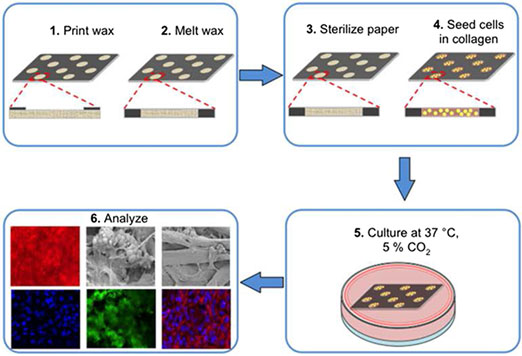Crossref Citations
This article has been cited by the following publications. This list is generated based on data provided by
Crossref.
Singh, Amrita Tribhuwan
Lantigua, Darlin
Meka, Akhil
Taing, Shainlee
Pandher, Manjot
and
Camci-Unal, Gulden
2018.
Paper-Based Sensors: Emerging Themes and Applications.
Sensors,
Vol. 18,
Issue. 9,
p.
2838.
Pupinyo, Naricha
Chatatikun, Moragot
Chiabchalard, Anchalee
and
Laiwattanapaisal, Wanida
2019.
In situ paper-based 3D cell culture for rapid screening of the anti-melanogenic activity.
The Analyst,
Vol. 144,
Issue. 1,
p.
290.
Suvarnapathaki, Sanika
Nguyen, Michelle A.
Wu, Xinchen
Nukavarapu, Syam P.
and
Camci-Unal, Gulden
2019.
Synthesis and characterization of photocrosslinkable hydrogels from bovine skin gelatin.
RSC Advances,
Vol. 9,
Issue. 23,
p.
13016.
Wu, Xinchen
Stroll, Stephanie I.
Lantigua, Darlin
Suvarnapathaki, Sanika
and
Camci-Unal, Gulden
2019.
Eggshell particle-reinforced hydrogels for bone tissue engineering: an orthogonal approach.
Biomaterials Science,
Vol. 7,
Issue. 7,
p.
2675.
Suvarnapathaki, Sanika
Wu, Xinchen
Lantigua, Darlin
Nguyen, Michelle A.
and
Camci-Unal, Gulden
2019.
Breathing life into engineered tissues using oxygen-releasing biomaterials.
NPG Asia Materials,
Vol. 11,
Issue. 1,
Castiaux, Andre D.
Spence, Dana M.
and
Martin, R. Scott
2019.
Review of 3D cell culture with analysis in microfluidic systems.
Analytical Methods,
Vol. 11,
Issue. 33,
p.
4220.
Suvarnapathaki, Sanika
Wu, Xinchen
Lantigua, Darlin
Nguyen, Michelle A.
and
Camci‐Unal, Gulden
2020.
Hydroxyapatite‐Incorporated Composite Gels Improve Mechanical Properties and Bioactivity of Bone Scaffolds.
Macromolecular Bioscience,
Vol. 20,
Issue. 10,
Vrana, Nihal Engin
2020.
Biomaterials for Organ and Tissue Regeneration.
p.
3.
Nguyen, Michelle A.
and
Camci-Unal, Gulden
2020.
Unconventional Tissue Engineering Materials in Disguise.
Trends in Biotechnology,
Vol. 38,
Issue. 2,
p.
178.
Rosqvist, E.
Niemelä, E.
Frisk, J.
Öblom, H.
Koppolu, R.
Abdelkader, H.
Soto Véliz, D.
Mennillo, M.
Venu, A. P.
Ihalainen, P.
Aubert, M.
Sandler, N.
Wilén, C.-E.
Toivakka, M.
Eriksson, J. E.
Österbacka, R.
and
Peltonen, J.
2020.
A low-cost paper-based platform for fast and reliable screening of cellular interactions with materials.
Journal of Materials Chemistry B,
Vol. 8,
Issue. 6,
p.
1146.
Lantigua, Darlin
Nguyen, Michelle A.
Wu, Xinchen
Suvarnapathaki, Sanika
Kwon, Seongjin
Gavin, Wendy
and
Camci-Unal, Gulden
2020.
Synthesis and characterization of photocrosslinkable albumin-based hydrogels for biomedical applications.
Soft Matter,
Vol. 16,
Issue. 40,
p.
9242.
Naik, Priyanka
Jaitpal, Siddhant
and
Paul, Debjani
2020.
The Resurgence of Paperfluidics: A new technology for cell, DNA, and blood analysis.
IEEE Nanotechnology Magazine,
Vol. 14,
Issue. 2,
p.
35.
Khetani, Sultan
Yong, Kar Wey
Guan, Kevin
Singh, Anupriya
Phani, Arindam
Kollath, Vinayaraj Ozhukil
Kim, Seonghwan
Karan, Kunal
Sen, Arindom
and
Sanati-Nezhad, Amir
2020.
UV-triggered polymerization of polycatecholamines enables the production of organ-on-chips inside a biosafety cabinet.
Applied Materials Today,
Vol. 20,
Issue. ,
p.
100721.
Alnemari, Roaa
Sukumar, Pavithra
Deliorman, Muhammedin
and
Qasaimeh, Mohammad A.
2020.
Paper‐Based Cell Cryopreservation.
Advanced Biosystems,
Vol. 4,
Issue. 3,
Agarwal, Tarun
Borrelli, Mimi R.
Makvandi, Pooyan
Ashrafizadeh, Milad
and
Maiti, Tapas Kumar
2020.
Paper-Based Cell Culture: Paving the Pathway for Liver Tissue Model Development on a Cellulose Paper Chip.
ACS Applied Bio Materials,
Vol. 3,
Issue. 7,
p.
3956.
Deliorman, Muhammedin
Sukumar, Pavithra
Alnemari, Roaa
and
Qasaimeh, Mohammad
2020.
A Method to Efficiently Cryopreserve Mammalian Cells on Paper Platforms.
BIO-PROTOCOL,
Vol. 10,
Issue. 18,
Wu, Xinchen
Walsh, Kierra
Hoff, Brianna L.
and
Camci-Unal, Gulden
2020.
Mineralization of Biomaterials for Bone Tissue Engineering.
Bioengineering,
Vol. 7,
Issue. 4,
p.
132.
Romo-Herrera, J.M.
Juarez-Moreno, K.
Guerrini, L.
Kang, Y.
Feliu, N.
Parak, W.J.
and
Alvarez-Puebla, R.A.
2021.
Paper-based plasmonic substrates as surface-enhanced Raman scattering spectroscopy platforms for cell culture applications.
Materials Today Bio,
Vol. 11,
Issue. ,
p.
100125.
Ahmed, Abdor Rahman
Gauntlett, Olivia C.
and
Camci-Unal, Gulden
2021.
Origami-Inspired Approaches for Biomedical Applications.
ACS Omega,
Vol. 6,
Issue. 1,
p.
46.
Wu, Xinchen
Zhang, Tengfei
Hoff, Brianna
Suvarnapathaki, Sanika
Lantigua, Darlin
McCarthy, Colleen
Wu, Bin
and
Camci‐Unal, Gulden
2021.
Mineralized Hydrogels Induce Bone Regeneration in Critical Size Cranial Defects.
Advanced Healthcare Materials,
Vol. 10,
Issue. 4,



